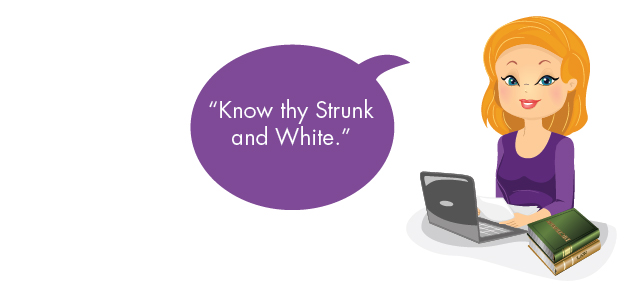
Fifty-eight years ago, the Macmillan Publishing Company commissioned famed essayist and children’s book author E.B. White to revise The Elements of Style, the “little book” penned in 1905 by William Strunk Jr., a professor of English composition at Cornell University.
In an article in The New Yorker and in his introduction, White deftly described Strunk’s “parvum opus” as his former professor’s “attempt to cut the vast tangle of English rhetoric down to size and write its rules and principles on the head of a pen.” Consisting originally of seven rules of usage, eleven principles of composition, “a few matters of form,” and a list of commonly misused words and expressions, The Elements was the exacting instructor’s “summation of the case of cleanliness, accuracy, and brevity in the use of English.”
White added a chapter called, “An Approach to Style,” where he offered such sage advice as “[d]o not overstate,” “[b]e clear” (“[c]larity, clarity, clarity!”), and “[a]void the use of qualifiers,” (“Rather, very, little, pretty–these are the leeches that infest the pond of prose, sucking the blood of words.”) In later editions, he added several rules of usage, updated examples, and deleted the obsolete.
Strunk, according to White, abhorred “the vague, the colorless, [and] the irresolute,” and advocated instead for “the clear, the brief, the bold.” To this day, the guidelines reflect the professor’s sentiments. The Elements instructs writers to dispense their words carefully, directly, and precisely—to aim for comprehensibility. And above all, “omit unnecessary words.”
A “deep sympathy for the reader” is evidenced throughout the book. As White put it, “[Strunk] felt that the reader was in serious trouble most of the time … floundering in a swamp, and that it was the duty of anyone attempting to write English to drain this swamp quickly and get [the reader] up on dry ground, or at least throw him a rope.”
No less sympathy is shown for readers of The Elements. Strunk and White elaborate on the rules and principles by providing examples of the incorrect on the left side of the page, with the correct version on the right.
Time magazine listed The Elements of Style as one of the 100 best and most influential books written in English since 1923. By 2009, more than ten million copies had been sold.
While some experts have criticized the manual as too “prescriptive,” far more consider it invaluable: a timeless guide to the fundamentals of good writing.
To avoid an unstudied, casual style (never appropriate in legal and other professional writing), or common mistakes in grammar and usage, remember this simple commandment: “Know thy Strunk and White.”
About the author:
Savannah Blackwell is a former news reporter who covered government and politics for more than a decade, mostly in San Francisco. She became a licensed California attorney in 2010 and specializes in legal research and writing. She can be reached at savannah.blackwell@gmail.com.


